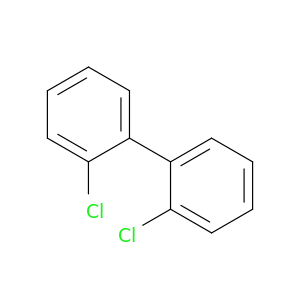
1,1'-Biphenyl, 2,2'-dichloro-
| Title | Journal |
|---|---|
| Metabolites of 2,2'-dichlorobiphenyl and 2,6-dichlorobiphenyl in hairy root culture of black nightshade Solanum nigrum SNC-9O. | Chemosphere 20121001 |
| Effects of polychlorinated biphenyls on the development of neuronal cells in growth period; structure-activity relationship. | Experimental neurobiology 20120301 |
| Evidence for unique and ubiquitous environmental sources of 3,3'-dichlorobiphenyl (PCB 11). | Environmental science & technology 20100415 |
| Screening of 397 chemicals and development of a quantitative structure--activity relationship model for androgen receptor antagonism. | Chemical research in toxicology 20080401 |
| Peroxidase-mediated removal of a polychlorinated biphenyl using natural organic matter as the sole cosubstrate. | Environmental science & technology 20070201 |
| A comparison of two techniques for studying sediment desorption kinetics of hydrophobic pollutants. | Chemosphere 20070101 |
| Dinuclear gold(I) isocyanide complexes with luminescent properties, and displaying thermotropic liquid crystalline behavior. | Inorganic chemistry 20061211 |
| Potential role for oxidative stress in 2,2'-dichlorobiphenyl-induced inhibition of uterine contractions but not myometrial gap junctions. | Toxicological sciences : an official journal of the Society of Toxicology 20060901 |
| Oxidative ring cleavage of low chlorinated biphenyl derivatives by fungi leads to the formation of chlorinated lactone derivatives. | Chemosphere 20060701 |
| Active-site engineering of biphenyl dioxygenase: effect of substituted amino acids on substrate specificity and regiospecificity. | Applied microbiology and biotechnology 20060601 |
| 2,2'-Dichlorobiphenyl decreases amplitude and synchronization of uterine contractions through MAPK1-mediated phosphorylation of GJA1 (connexin43) and inhibition of myometrial gap junctions. | Biology of reproduction 20051101 |
| Evolution of the biphenyl dioxygenase BphA from Burkholderia xenovorans LB400 by random mutagenesis of multiple sites in region III. | The Journal of biological chemistry 20041112 |
| Revisiting the regiospecificity of Burkholderia xenovorans LB400 biphenyl dioxygenase toward 2,2'-dichlorobiphenyl and 2,3,2',3'-tetrachlorobiphenyl. | The Journal of biological chemistry 20041112 |
| Effect of sorbate planarity on environmental black carbon sorption. | Environmental science & technology 20040701 |
| Mechanochemical removal of organo-chlorinated compounds by inorganic components of soil. | Chemosphere 20040601 |
| Vesicular catecholamine release from rat PC12 cells on acute and subchronic exposure to polychlorinated biphenyls. | Toxicology and applied pharmacology 20020915 |
| Foci formation of MCF7 cells as an in vitro screening method for estrogenic chemicals. | Environmental toxicology and pharmacology 20020301 |
| Dechlorination of polychlorobiphenyls using NaBH(4) and NaBH(4)/LiCl at 120-310 degrees C in glyme solvents. | Journal of hazardous materials 20010420 |
| Possible molecular targets of halogenated aromatic hydrocarbons in neuronal cells. | Biochemical and biophysical research communications 20010209 |